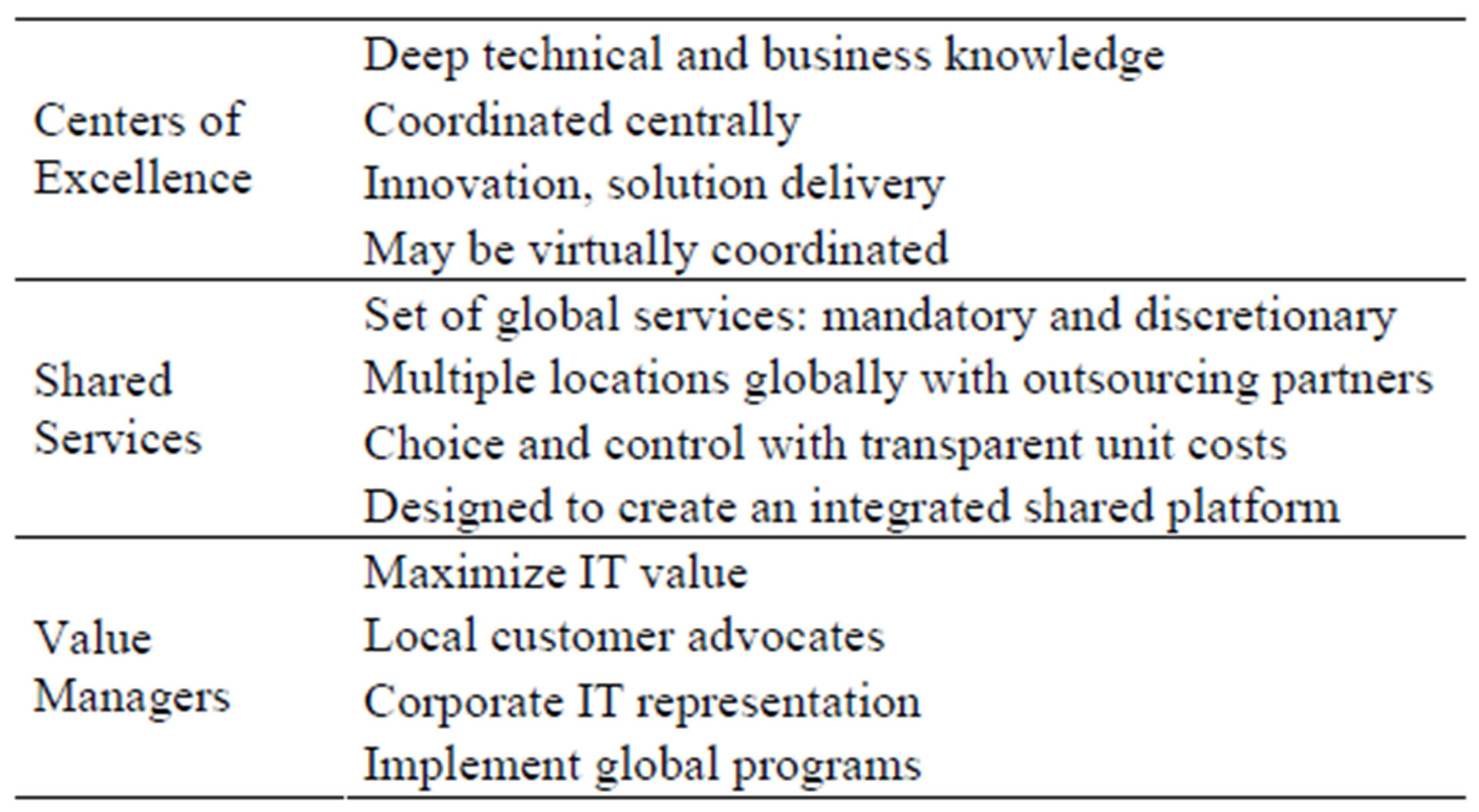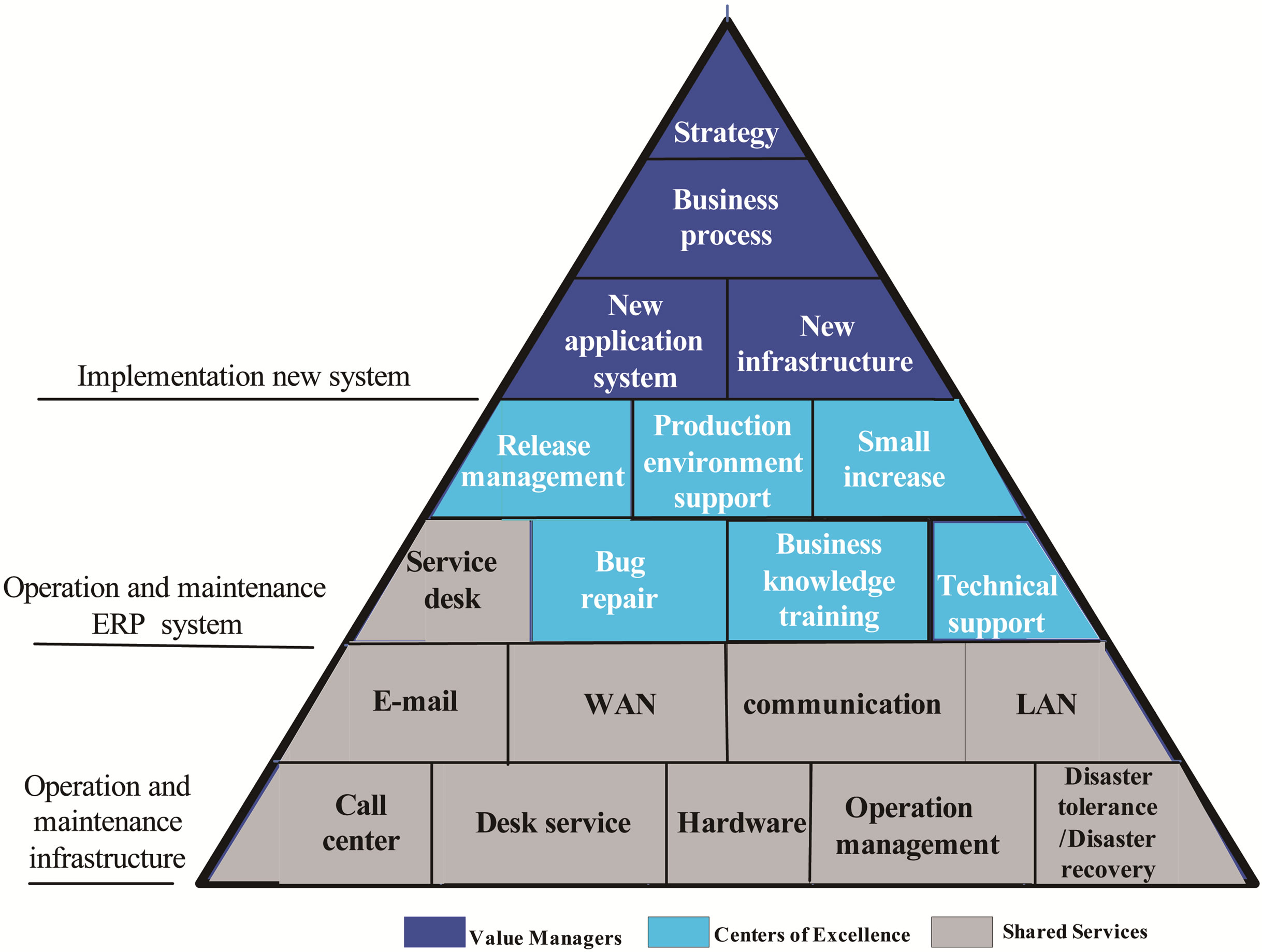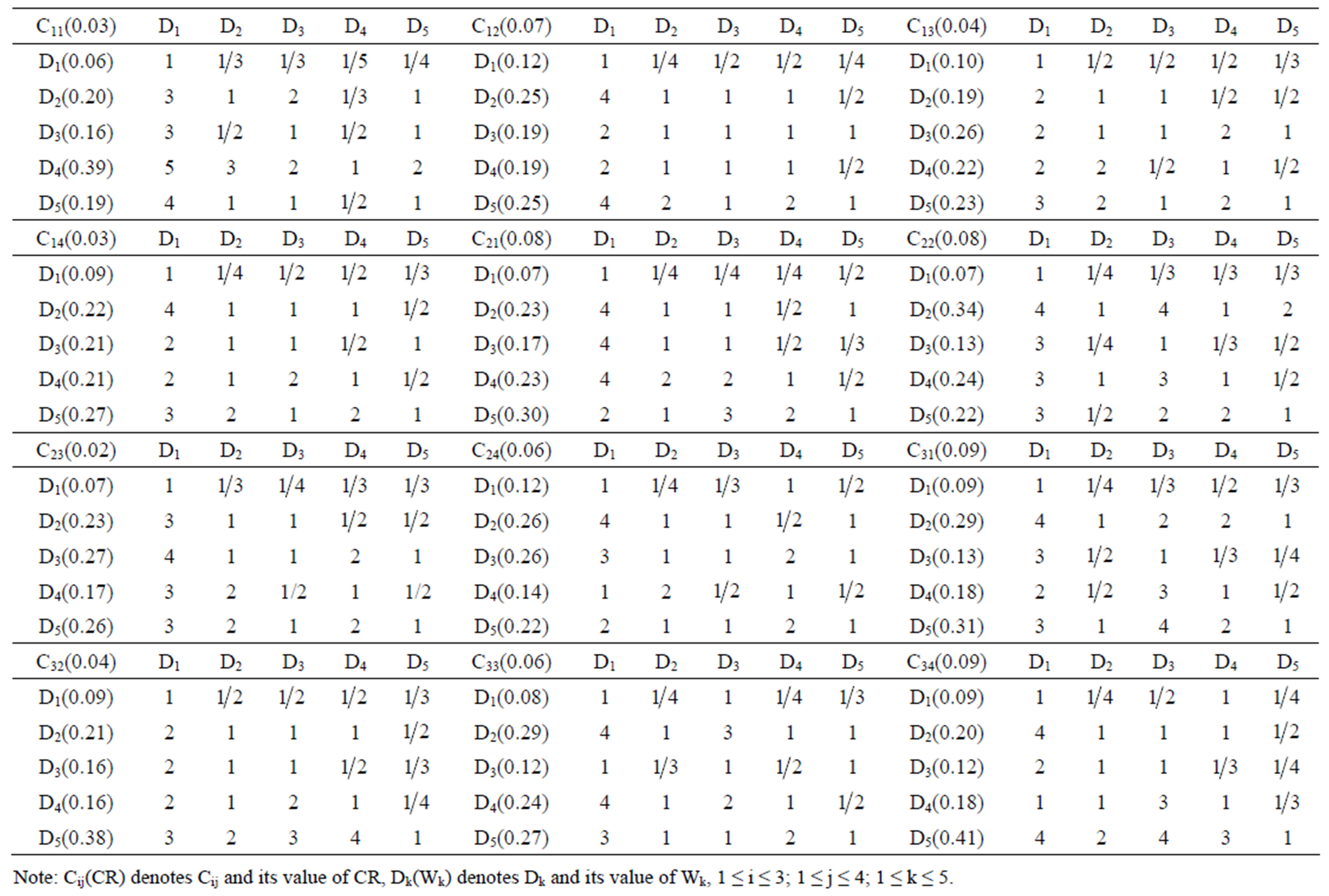Technology and Investment
Vol.3 No.3(2012), Article ID:22073,6 pages DOI:10.4236/ti.2012.33019
Case Study on M Company Best Practice with Global IT Management*
1School of Business Administration, South China University of Technology, Guangzhou, China
2Institute of Emerging Industrialization Development, South China University of Technology, Guangzhou, China
Email: scutwjp@126.com, 294663012@qq.com
Received June 8, 2012; revised July 3, 2012; accepted July 10, 2012
Keywords: Global IT Management; IT Service Management; Enterprise Resource Planning; Centers of Excellence, Shared Services; Value Managers; Critical Success Factors; Analytic Hierarchy Process; Best Practices
ABSTRACT
The propose of research is to help those global companies to improve their IT service management (ITSM) more effectively. The ITSM of M company is analyzed with global IT management model, which contains 12 structuring elements, and the structuring elements model and their best practices are established in the IT service operation and maintenance process in the views of centers of excellence, shared services and value managers. Both the 12 structuring elements and 5 M company’s best practices of ITSM are rated with both critical success factors and analytic hierarchy process. The best practices are in the following: good relationship with customers (0.279), seamless and efficient department cooperation (0.231), team proficient in business and enterprise resource planning professional knowledge (0.226), highquality library of knowledge management (0.176) and educational training (0.088).
1. Introduction
Information Technology Service Management (ITSM) based on Information Technology Infrastructure Library (ITIL), which integrates the best practices of global IT management and forms the normative truth standard to reduce effectively cost and improve the quality of service, is applied widely in the world [1]. The whole framework of ITIL was developed by the Central Computer and Telecommunications Agency (CCTA, merged with the OGC) of the UK government in the middle of 1980s, is a set of service management standard library which focuses on IT industry. In the past 20 years, the content of ITIL has been updated and renewed. Today the OGC has enacted the ITIL 3.0.
IT organization structure depends on enterprise organization structure. Meanwhile, for multinational corporation (MNC) and diversified enterprises, to be centralized headquarters or branch decentralization has long been the hot topic in the business circles. However, whatever IT organization structure is adopted, how to divide IT management responsibilities and rights is still the key point. IT department of M company can be divided into there parts according to responsibilities: centers of excellence, shared services, and value managers.
This paper is organized in the following: Section 2 is literature review, including ITSM, and Enterprise Resource Planning (ERP) and their critical success factors (CSF), and global IT management model. Section 3 is to build global IT management structuring element model of M company. Section 4 is to rank best practices of ITSM structuring elements of M Company. Section 5 is management lessons. Finally, Section 6 is conclusions.
2. Literature Review
2.1. IT Service Management and Enterprise Resource Planning
Wui-Gee Tan, Aileen Cater-Steel, Mark Toleman used the CSF approach to examine the experience of Queensland Health, which is a large Australian government agency, implemented a centralized IT service management model based on the ITIL framework, and reviewed CSF studies related to ERP implementation for insights and directions since ITSM implementation shares many of the features of ERP: 1) ERP and ITSM projects require considerable financial resources and are risky; 2) As both ERP and ITSM are built on best practices, some “customization” in the form of changes to the business processes is necessary to ensure that the resulting system will meet the needs of the organization; 3) Organizations implementing ERP and ITSM commonly engage vendors to leverage the deep knowledge that these external parties gather from their experience with a wide range of clients; 4) Change management is a central issue in both ERP and ITSM implementation as they require staff to work across functions under a redesigned process environment [2].
2.2. The Critical Success Factors of ITSM
The CSF approach was first established in the 1960s and popularized by various researchers, including Rockart and Bullen [3] who provided an operational definition of CSF: “key areas where things must go right in order to successfully achieve objectives and goals”. It has been pointed out by Williams and Ramaprasad [4] that although the CSF approach is widely used by researchers to produce a plethora of factors, it is important to discriminate between different levels of criticality.
They distinguish four types of criticality: 1) Factors linked to success by a known causal mechanism; 2) Factors necessary and sufficient for success; 3) Factors necessary for success; and 4) Factors associated with success. This research offers guidelines to practitioners by focusing on the fourth level. We identify a set of CSFs associated with successful ITSM implementation.
The study of Wui-Gee Tan, Aileen Cater-Steel, Mark Toleman indicates that the commitment of senior management is crucial to the project’s success as is a project champion and the recognition of the need for an appropriate change management strategy to transform the organizational culture to a service-oriented focus. Maintaining close and forthright relationships with multiple vendors facilitates technology transfer to in-house staff while a benefits realization plan is a valuable tool for tracking and communicating tangible and intangible project benefits to the project stakeholders. An effective project governance and execution process further contributes to the implementation success [2].
The study of Wan J.P. etc. indicates if the organization wishes to successfully implement ITSM’s customer satisfaction model, it should eliminate the misunderstandings of ITSM objectives first, while the adoption of knowledge supporting structure of ITSM can play a multiplier effect [5], and enterprise interview and questionnaire survey are used to establish and verify the relational model between the root risk factors of implementation of the ITSM project and the six complexity propositions based grounded theory [6], and Warfield version of systems science supports a wide variety of application areas, and is useful to practitioners that use the Work Program of Complexity (WPOC) tool, WPOC is applied to ITSM for managing the complexity of projects, and both process priorities checklist and ten keys to successful implementation of ITSM projects are put forward [7].
2.3. Global IT Management
Siew Kien Sia, Christina Soh, and Peter Weil put forward the structural global IT management model (Table 1). Despite the variation in industry, all the MNCs studied used three common structural elements to link the enterprise wide IT leadership (who design and oversee enterprise wide IT governance, the IT budget, and portfolio management, enterprise architecture, and enterprise risk management), and the more locally focused concerns of the business units. Although companies sometimes labeled these elements differently, such as, shared services, centers of excellence (CoEs), and value managers (VMs), the goals of each element were the same across the firms. The objective of shared services was to achieve scale economies; the objective of CoEs was to drive innovation; and the objective of value managers was to enable responsiveness. The ITSM of M Company is analyzed in this paper with global IT model, which contains 12 structural elements, and its best practices are discovered in the IT service operation and maintenance process in the views of centers of excellence, shared services and value managers [8].
3. Building Global IT Management Structuring Element Model of M Company
3.1. Global IT Management of M Company
Global Shared Services are mainly responsible for maintenance of global service desk, computer room and other hardware facility, installation of software, network maintenance and etc. (Table 2). ERP of Centers of Excellence is mainly responsible for enterprise information system operation and maintenance. M company distributes the responsibilities of the operation and maintenance personnel by ERP system modules. The operation and maintenance personnel in different modules are in charge of different business modules. IT Value Managers, for the most of time in the first line of business responding to the new demand and development of the business, are responsible for on-line development of new system or new function in time.

Table 1. Structural global IT management model.
3.2. Best Practices on ITSM Structure Elements
M company, based on ITIL’s ERP operation and maintenance management process, can effectively support its global ERP system users. After users report their events, service desk will then unite with ERP Centers of Excellence Department and other departments to solve events, cope with problem, deliver solution and then carry out system configuration, change and release management. However, how to understand the local customer new demand in time and implement IT plan to the world so as to maximize IT value? M company as a fast food consumption multinational corporation has the same structured elements, which are Centers of Excellence, Shared Services and Value Managers (Figure 1) with those multinational companies source structure strives for the so-called large-scale and in other industry on the organization structure. All these suggest that global IT meanwhile realize local response and innovation.
The issues were sent to each team member in the questionnaire. And then we collect and analyze questionnaires. After that, we offered the feedback on the conclusion and choice reasons of each colleague to each member of the team. Finally, through an interview with each team member and then a brief meeting with all team members together, a consensus on the conclusion had been achieved and thus best practices were established. They are as follows: educational training, seamless and efficient department cooperation, library of knowledge management with highquality, team proficient in business and ERP professional knowledge and good relationship with customers.
3.3. Weight Calculation and Consistency Check on ITSM Structure Elements
This paper attempts to rank these best practices, which are recognized with global IT management, with AHP (Table 3).

Table 2. IT organization structure of M company.

Figure 1. IT service structure of M Company.

Table 3. AHP evaluation model.
Eight experts, including IT system manager of M company, IT experts and other experts are involved to give scores to judgment matrix. According their scores, we got the geometric mean, put it into the integer and built new judgment matrix. The judgment matrices are as follows (Tables 4 and 5).
According to the above calculation results, we can see that the C.R. values of all the judgment matrices are less than 0.1. Therefore, all judgment matrices pass the consistency check and the results are proved reliable. Multiply weights of the first class indexes (B level) by weights of the second class indexes (C level), we can get weights of each second class index in the whole model. Then we provide a correct order for first and second class indexes according to each weight. The results are as follows (Table 6).

Table 4. A-B judgment matrix and weights.

Table 5. B-C judgment matrices and weights.
4. Raking on Best Practices of ITSM Structuring Elements of M Company
Building judgment matrix on project level, which is based on the best practices of structure elements, already found. Experts gave each second class index scores on every best practice of structure elements and then got the geometric mean of all the scores. Meanwhile, they put the results of scores into the integer, got the geometric mean and then multiplied them by corresponding weight of second class indexes. Finally, they have obtained the structure elements scoring table as Table 7. Among the Best practices, Educational training, Seamless and efficient department cooperation, Library of knowledge management with high quality, Team proficient in business and ERP professional knowledge and Good relationship with customers in the following table are replaced by D1, D2, D3, D4 and D5 respectively. Digitals below relationship with customers in the following table are replaccells which contain the content of C level in the table represent values of consistency ratio. Digitals below cells which include number D1, D2, D3, D4 and D5 represent its weight correspondingly (Table 7).
According to the above calculation results, the C.R. values of all the judgment matrices are less than 0.1. Therefore, all judgment matrices pass the consistency check and the results are proved reliable. Then we scored all the second class indexes corresponding to each structure element, put the results of those scores into the integer, got the geometric mean and then multiplied them by their corresponding weights of second class indexes. Finally, we got the structure elements scoring table below (Table 8).
5. Lessons for Managers
There are six different levels in the ITSM architecture model [7]. Each level considers different problems relative to services, and determines the priorities of the ITIL modules. We give the best practices according process priorities checklist of ITSM architecture model (Table 9).

Table 6. Weights of all indexes.

Table 7. Best practice of IT service management structure elements.

Table 8. Structural elements best practice scoring table.

Table 9. Process priorities checklist.
6. Conclusions
Based on the case study of M company, a structure element model on IT service operation and maintenance process has been built from three aspects, namely, Centers of Excellence, Shared Services, Value Managers. 12 key success factors in the model are as follows: Deep technical and business knowledge, Coordinated centrally, Innovation and solution delivery, May be virtually coordinated, Set of global services: Mandatory and discretionary, Multiple locations globally with outsourcing partners, Choice and control with transparent unit costs, Designed to create an integrated shared platform, Maximize IT Value, Local customer advocates, Corporate IT representation IT, Implement global programs. Based on 12 key success factors, and we have given a correct order to first class indexes and second class indexes with AHP, besides, we have calculated weights of each class index in the whole evaluation model in this paper.
According to these and a combination with best structure element practices on IT service management of M company, we have given comprehensive scores to each structure element’s best practice with AHP and found out their priorities. For the evaluation model weight design of IT service management’s key success factors, with a combination of qualitative and quantitative research method, the weights are more objective and the evaluation results are quite accurate. The model is not only simple and easy to use, but also enjoys strong maneuverability and applicability. To some extent, it can be used to guide the operation and maintenance process of IT company service management. And as a result, IT service commercial success rate will be greatly increased.
7. Acknowledgements
Thanks for helpful discussion with Mr. Yuxuan Zhang etc.
REFERENCES
- J. van Bon, M. Picper and A. der Veen, “Foundations of IT Service Management Based on ITIL,” Van Haren Publishing, Zaltbommel, 2005.
- W.-G. Tan, A. Cater-Steel and M. Toleman, “Implementing IT Service Management: A Case Study Focusing on Critical Success Factors,” Journal of Computer Information Systems, Vol. 50, No. 2, 2009, pp. 1-12.
- J. Rockhart and C. Bullen, “A Primer on Critical Success Factors, Center for Information Systems Research,” Massachusetts Institute of Technology, Cambridge, 1981.
- J. J. Williams and A. Ramaprasad, “A Taxonomy of Critical Success Factors,” European Journal of Information Systems, Vol. 5, No. 5, 1996, pp. 250-260. doi:10.1057/ejis.1996.30
- J. P. Wan, H. Zhang and D. Wan, “Evaluation on Information Technology Service Management Process with AHP,” Technology and Investment, Vol. 2, No. 1, 2011, pp. 38-46. doi:10.4236/ti.2011.21005
- J. P. Wan and D. Wan, “Analysis on the Mindbugs in Information Technology Service Management Project Implementation,” Technology and Investment, Vol. 2, No. 3, 2011, pp. 184-192. doi:10.4236/ti.2011.23019
- J. P. Wan and J. Jones, “Managing ITSM Implementation Complexity: A Warfield Version of Systems Science Perspective,” Enterprise Information Systems, 2012, in Press.
- S. K. Sia, C. Soh and P. Weill, “Global IT Management,” Communications of the ACM, Vol. 53, No. 3, 2010, pp. 59-64. doi:10.1145/1666420.1666449
NOTES
*This research was supported by Key Project of Guangdong Province Education Office (06JDXM63002), NSF of China (70471091).

